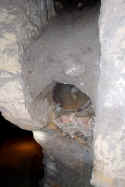|
Nottingham Miscellany NOTTINGHAM
CAVES |
|||||
|
The City of Nottingham and much of the surrounding area stands on what was once known as 'bunter sandstone' but is now commonly referred to as 'Sherwood Sandstone', a rich orange / brown coloured porous rock that is very easily worked with quite basic implements. Because of this, generation after generation of city dwellers going back many centuries, have worked the rock to create dwellings, places of work, or more commonly, just additional rooms and cellars under or at the back of more conventional houses. More recently many caves were used as air-raid shelters during WW2. Hundreds of these caves still exist but the vast majority are in private ownership and not generally open to the public. The photographs below were taken during a tour of caves organised by The Nottingham Civic Society to whom I am indebted for kindly inviting me to join them. The tour was to caves in what was the old Drury Hill / Low Pavement area, some of which are open to the public and others that are not. |
|||||
| - | |||||
| - | |||||
| SCROLL DOWN TO SELECT THEN CLICK ON THUMBNAIL TO VIEW ENLARGED IMAGE | |||||
| - | |||||
| 'The City of Caves' | |||||
|
The
first
set
of
photographs
were
taken
in
'The
City
of
Caves'
a
visitor
attraction
run
by
the
Egalitarian
Trust
,
a
registered
charity.
These
caves
have
been
dressed
up
to
illustrate
the
uses
to
which
they
were
put,
and
to
provide
more
interest
to
the
visitor.
They
are
accessible
from
an
entrance
on
the
upper
mall
of
The
Broad
Marsh
shopping
centre.
Visit
their
web
site
for
more
details:
http://www.cityofcaves.com/ |
|||||
| - | |||||
 |
|||||
| NM00521 | NM00522 | NM00523 | NM00524 | ||
| NM00525 | NM00526 | NM00527 | NM00528 | ||
| NM00529 | NM00530 | NM00531 | NM00532 | ||
| NM00533 | NM00534 | NM00535 | NM00536 | ||
| NM00537 | NM00538 | NM00539 | NM00540 | ||
| - | |||||
| 'The Western Caves' | |||||
|
The six photographs below show more caves very near to those in the above section. These caves are still being cleared and explored by a team of dedicated volunteers and are NOT open to the general public. If funds can be found, it is hoped that at some point in the future, they will be included in the 'City of Caves' visitor attraction. The most interesting feature is a cave that clearly was once a stable for horses. |
|||||
| NM00541 | NM00542 | NM00543 | NM00544 | ||
| NM00545 | NM00546 | ||||
| - | |||||
| The Willoughby House Caves | |||||
|
Not far away from the old Drury Hill lies Low Pavement, towards the top of which stands the impressive Willoughby House that is now home to the Paul Smith fashion store. Under the gardens of this fine house are the three caves shown below. They were originally accessed via a steep staircase from the house garden but in WW2 they were used as air-raid shelters and to facilitate easy access by the public, a second narrow access tunnel was created from a small piece of 'no mans land' that is now behind the Broad Marsh Centre. The original purpose of these impressive chambers is not clear but it is believed that they were used for drinking parties where the gentry could enjoy a cool drink in equally cool surroundings. They would also no doubt have been used for the general storage of wines and ales. When entering from the house one would descend the stairs and arrive at a short tunnel. To the right and left are further short tunnels leading to two very similar chambers with central supports. Moving straight on from the bottom of the stairs one enters the main much larger chamber with its massive decorated central support |
|||||
| NM00547 | NM00548 | NM00549 | NM00550 | ||
| NM00551 | NM00552 | NM00553 | NM00554 | ||
| NM00555 | NM00556 | ||||
|
Other
examples
of
Nottingham
sandstone
caves
and
tunnels
that
can
be
found
on
this
web
site CLICK ON THE RED LINKS |
|||||
| - | |||||
| The Park or The Duke of Newcastles Tunnel |
Accessible
by
the
public
from
Derby
Road,
The
Ropewalk
or
via
Tunnel
Road
from
The
Park
Estate. |
||||
| Sneinton Hermitage |
NOT
generally
open
to
the
public,
but
look
out
in
the
local
press
for
special
Heritage
Day
openings.
The
fronts
of
caves
are
visible
from
street. |
||||
| The Rock Cemetery |
Whilst
the
cemetery
is
open
to
the
public,
the
catacomb
tunnel
is
NOT. |
||||
| The Castle Rock Caves |
The
caves
within
the
Nottingham
Castle
rock
are
open
to
the
general
public
for
guided
tours
on
limited
days
of
the
week.
Check
on
opening
times
before
visiting.
Also
note
that
this
tour
is
not
likely
to
be
suitable
for
the
disabled
or
infirmed
as
there
are
approximately
300
steps
to
be
climbed
either
up
or
down. |
||||
| Hollowstone |
None of these caves are open to the public. All are either bricked up or barred but the entrances are clearly visible. |
||||
| - | |||||
| SCROLL UP TO SELECT THEN CLICK ON THUMBNAIL TO VIEW ENLARGED IMAGE | |||||
| A | |||||
| a | |||||
| - | |||||
| - | |||||
| - | |||||
| - | |||||
|
|||||